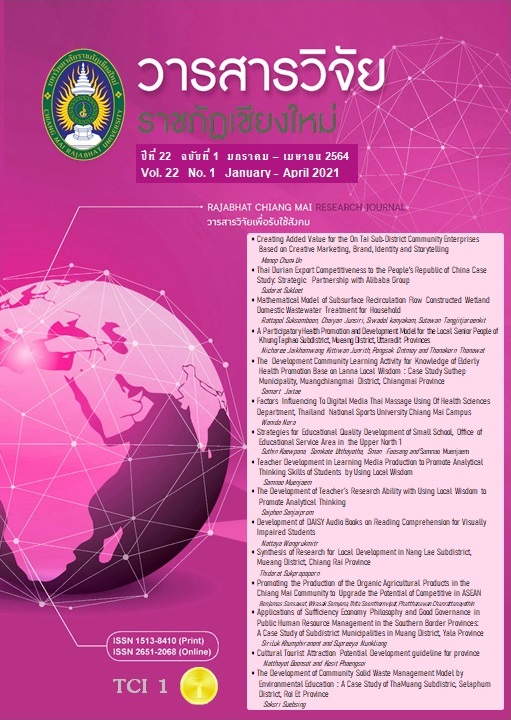Creating Added Value for the On Tai Sub-District Community Enterprises Based on Creative Marketing, Brand, Identity and Storytelling
DOI:
https://doi.org/10.14456/rcmrj.2021.246492Keywords:
Community enterprises, Creative marketing, Brand, Market positioning, Value-added, Identity, StorytellingAbstract
This research focused on creating added value for the community enterprises of the On Tai sub-district based on creative marketing, brand identity, brand positioning, and storytelling. The research involved the application of the mixed method as the qualitative research instrument, which consisted of in-depth interviews and group discussions, while the quantitative instrument consisted of questionnaires administered to 400 tourists and 20 experts within the On Tai community context. The content and descriptive statistics were for data analysis. The findings of creating value-added from creative marketing showed that the community must create a common experience for tourists to learn the spirit of the place and experience the genuine charm of the community, and the community must develop souvenir products for distribution and sale on community tourist routes. Branding results indicated that a brand portfolio would include a family brand under On Tai with the logo of three fishes moving clockwise in a circle with a floral in the center and a slogan that describes the identity of the community as the land of watershed fertility and peacefulness. The market positioning was to describe the community as the land of peace with various tourist attractions, and the products containing a quality of wisdom. The result of identity creation determined by the Delphi technique showed that the most notable physical characteristics were the landscape and natural environment, with a mean score of 4.10, the most notable local activity was the lifestyle with a mean of 3.95, and qualities of symbolism and wisdom were learning centers and service centers with a mean of 3.90. Finally, the storytelling finding showed that the characters branded the place with the family name “On Tai” which was derived from the location of the On Tai community.
Downloads
References
Aaker, D.A. (1996). Building Strong Brands. New York: The Free Press.
Artitkawin, A., Intakhan, P., &Thongsuk, J. (2019). The Added Values of Ceramic Brand by Developing Packaging Formats for Competitive Opportunities of Small Enterprises in Wares, Decorations, and Souvenirs Lampang. Graduate School Journal Chiang Rai Rajabhat University, 12(1), 1-12. (In Thai)
Barwise, P. (2013). Marketer's Toolkit. (6thed.). Bangkok: Expernet.
Best, JW. (1977). Research in Education. (3rd ed.). New Jersey: Prentice Hall.
Chamnian, M. (2019). Community Identity Communication for Tourism Promotion. The Journal of Management and Development Ubon Ratchathani Rajabhat University, 6(1), 235-265. (In Thai)
Department of Business Development Ministry of Commerce. (2019). Business development handbook. Retrieved from http://www.dbd.go.th. (In Thai)
Kaewsanga, P. & Chamnongsri, N. (2012). Creative Tourism: A New choice of Thai Tourism. Suranaree Journal of Social Science, 6 (1), 91-109. (In Thai)
Kapferer, J. N. (2008). New Strategic Brand Management: Creating and Sustaining Brand Equity Long Term. (4 thed.). London: Kogan.
Meak-on, S., & Bejarananda, M. (2013). Tourism Impact on Community Identity: Case of Amphawa. Community. Academic Journal : Faculty of Architecture, Khon Kaen University, 12(2), 1-19. (In Thai)
MRG Online. (2020). Launched “9 Pilot Communities to Explore Creative Industrial Villages”. Retrieved from https://mgronline.com/travel/detail/9600000023398 (In Thai)
Neawheangtham, K. R. (2017). The Guideline of the Local Wisdom Product Development for Promote Creative Economy in Nakhon Pathom Province. Veridian E-Journal, Silpakorn University, 10(1), 994-1013. (In Thai)
Nogué, J., & De San Eugenio Vela, J. (2018). Geographies of affect: In search of the emotional dimension of place branding. Communication & Society, 31(4), 27-44.
On Tai Municipality. (2020). General Condition and Important Basic Information of On Tai Municipality. Retrieved from https://www.ontai.go.th/ (In Thai)
Pankasem, T., & Prajakanet, P. (2016). Participatory communication for promoting creative tourism in NAN. At the 2016 National Academic Seminar, Faculty of Communication Arts and Management Innovation. (Nor.155). National Institute of Development Administration, 1st July 2016, Bangkok National Institute of Development Administration. (In Thai)
Panyarot, S. (2017). Marketing: Outlaw Strategy. Bangkok: Phetpraguy. (In Thai)
Phanomprai, P. (2015). Creative Marketing of Occupational Groups of Processed Banana Producer in Chiangrai through the Philosophy of Self-Sufficient Economy. RMUTL Journal of Humanities and Social Sciences, 3(1), 56-73. (In Thai)
Pinkhiao, S., & Tantivejakul, N. (2017). The Brand Globalness Communicated by Global and Local Brand in Thailand. Journal of Business, Economics and Communications, 12 (2), 93-109. (In Thai)
Prommaroeng, S. (2018). The Elevation Approach of OTOP’s Foods which Produced in Mae Ban Rim Rong Community Enterprise of Makeujae Sub-district, Muang District, Lamphun Province. Journal of Social Science, Srinakharinwirot University, 21(1), 248-249. (In Thai)
Ries, A., & Throut, J. (2003). Positioning: the battle for your mind. Bangkok: Se-Education.
Rossiter, J. R., Percy, L., & Bergkvist, L. (2018). Marketing communications: Objectives, strategy, tactics. New York: Sage.
Sakrawat, S. (2019). Story Telling, Telling Stories, Stories. Bangkok: Thai Koon-Brand Age. (In Thai)
Srisathit, R. (2019). Decode to Create a "Thai brand" to Turn a Bang from "OTOP" to a National Product - Go Inter. Retrieved from https://positioningmag. com/1245227 (In Thai)
Tahom, U., ฿ Senarat, S. (2019). Course for Adding Economic Value to Rolled Water Cultural Product of Baan Yang Community Enterprise Group, Baan Yang Sub-district, Muang District, Buriram Province. Journal of Research and Development, Buriram Rajabhat University, 14(1), 7-25. (In Thai)
Thanyarattakul, T. (2018). Digital Transformation in Action: Transforming Business in the Digital Age Step by Step. Bangkok: C&N Book. (In Thai)
Verawat, A., & Sungrugsa, N. (2018). Sustainable creative tourism in World Heritage Site of Phra Nakorn Sri Ayutthaya: Revisited the Mission?. Veridian E-Journal, Silpakorn University, 11(2). 3084-3097. (In Thai)
Wantamay, N. (2018). Marketing for Sustainability. Bangkok: Chulalongkorn University Press. (In Thai)
Wheeler, k. (2020). How to develop a unique (& Memorable) brand identity in 2020. Retrieved from https://blog.hubspot.com/agency/develop-brand-identity
Yamane, T. (1967). Statistics: An Introductory Analysis. (2nd ed.). New York: Harper & Row.
Downloads
Published
How to Cite
Issue
Section
License
1. Articles, information, content, images, etc published in the “Community and Social Development Journal” are copyrighted by the Community and Social Development Journal, Chiang Mai Rajabhat University. In order to properly distribute the articles through print and electronic media, the authors still hold the copyright for the published articles under the Creative Commons Attribution (CC BY) license, which allows the re-distribution of the articles in other sources. References must be made to the articles in the journal. The authors are responsible for requesting permission to reproduce copyrighted content from other sources.
2. The content of the articles appearing in the journal is the direct responsibility of the article authors. The editorial board of the journal does not necessarily agree with or share any responsibility.














